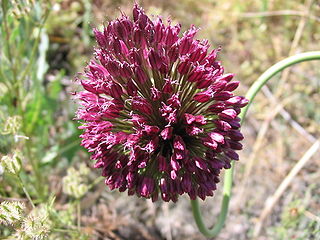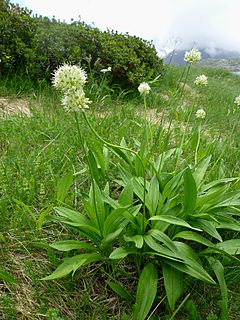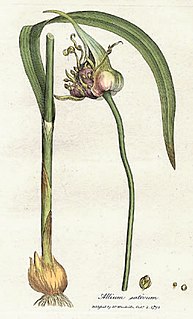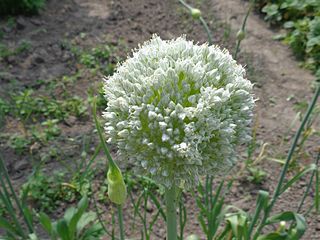
Chives, scientific name Allium schoenoprasum, is a species of flowering plant in the family Amaryllidaceae that produces edible leaves and flowers. Their close relatives include the common onions, garlic, shallot, leek, scallion, and Chinese onion.

Allium canadense, the Canada onion, Canadian garlic, wild garlic, meadow garlic and wild onion is a perennial plant native to eastern North America from Texas to Florida to New Brunswick to Montana. The species is also cultivated in other regions as an ornamental and as a garden culinary herb. The plant is also reportedly naturalized in Cuba.

The sand leek, also known as rocambole and Korean pickled-peel garlic, is a Eurasian species of wild onion with a native range extending across much of Europe, Middle East, and Korea. The species should not be confused with rocambole garlic, which is A. sativum var. ophioscorodon.

Allium sphaerocephalon is a plant species in the Amaryllis family known as round-headed leek and also round-headed garlic, ball-head onion, and other variations on these names. Other names include Drumsticks, and in Germany, Kugellauch. Some publications use the alternate spelling A. sphaerocephalum. It is a hardy perennial plant.

Allium victorialis, commonly known as victory onion, Alpine leek, and Alpine broad-leaf allium is a broad-leaved Eurasian species of wild onion. It is a perennial of the Amaryllis family that occurs widely in mountainous regions of Europe and parts of Asia.
Salvatore Brullo is professor at University of Catania since 1980 teaching Systematic Botany, he degree in biological science during 1969. For six years he was Director of the Department of Botany, at the University of Catania.

Allium paniculatum, common name pale garlic It is widely cultivated and is now naturalized in several places outside its native range.
Allium archeotrichon is a species of onion endemic to the east Aegean islands – Rhodes, Tilos and Symi. It is a bulb-forming perennial with a scent resembling that of onions or garlic. It produces an umbel of flowers.

Allium is a genus of monocotyledonous flowering plants that includes hundreds of species, including the cultivated onion, garlic, scallion, shallot, leek, and chives. The generic name Allium is the Latin word for garlic, and the type species for the genus is Allium sativum which means "cultivated garlic".

The precise taxonomy of the genus Allium is still poorly understood with incorrect descriptions being widespread. With over 850 species distributed over the Northern hemisphere Allium is the sole genus in the Allieae, one of four tribes of subfamily Allioideae (Amaryllidaceae). New species continue to be described and Allium is both highly variable and one of the largest monocotyledonous genera, but the precise taxonomy of Allium is poorly understood, with incorrect descriptions being widespread. The difficulties arise from the fact that the genus displays considerable polymorphism and has adapted to a wide variety of habitats. Furthermore, traditional classications had been based on homoplasious characteristics. However, the genus has been shown to be monophyletic, containing three major clades, although some proposed subgenera are not. Some progress is being made using molecular phylogenetic methods, and the internal transcribed spacer (ITS) region, including the 5.8S rDNA and the two spacers ITS1 and ITS2, is one of the more commonly used markers in the study of the differentiation of the Allium species.
Allium talyschense is a critically endangered species of wild onion native to the South Transcaucasia region of Armenia, between the villages Gnishik, Khachik and in Talish. A. talyschense has no conservation actions.
Allium drobovii is a species of onion native to the southwestern spurs of the Talas Alatau and the Karatau Mountains in Kazakhstan and Uzbekistan. The plant is in the amaryllis family, originally described by Alexei Ivanovich Vvedensky. A. drobovii does not have any subspecies listed in the Catalog of Life.
Allium brachyspathum is a species of plant in the amaryllis family and is endemic to Greece.
Allium cithaeronis is a plant species in the amaryllis family and is native to Greece.
Allium dirphianum is a species of plant in the amaryllis family and is native to Greece.
Allium karistanum is a species of plant in the amaryllis family and is native to Greece.
Allium makrianum is a species of plant in the amaryllis family and is native to Greece.
Allium phitosianum is a species of plant in the amaryllis family and is native to Greece.
Allium rhodiacum is a species of plant in the amaryllis family and is native to the East Aegean Islands.
Allium thessalicum is a species of plant in the amaryllis family and is native to Greece.








